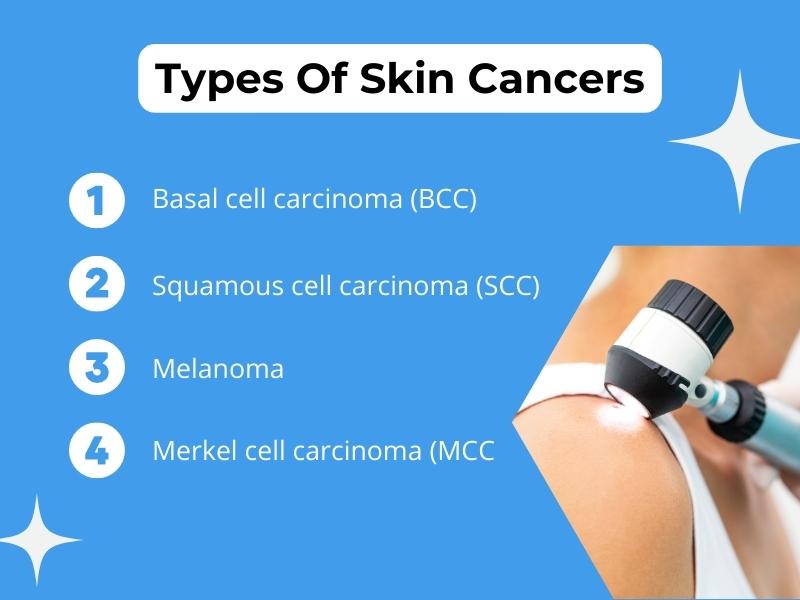Although skin cancer can look different for each person due to skin tone, size, type, and location of the body, one (1) out of five (5) individuals will develop skin cancer by the age of 70. According to the Skin Cancer Foundation, skin cancer is the growth of abnormal cells on the outermost skin layer, the epidermis. There are many different causes of skin cancer, but changes in an individual’s DNA sequence is a main cause of skin cancer development. These changes can lead the skin to multiply rapidly, forming tumors.

There are two leading causes of skin cancer. These causes are the sun’s harmful ultraviolet (UV) rays and the use of UV tanning beds. Unlike cancers that develop inside the body, skin cancers form outside the epidermis and are usually visible. The good news is that in most cases skin cancer is curable if diagnosed and treated early. Learning how to detect cancer early is critical, so it is imperative to look for anything new, changing, or unusual on your skin. Dermatologists recommend scheduling an annual professional skin exam and also checking your skin monthly to look for new and changing moles. Now that you know what causes skin cancer let’s discuss the main types.

Basal cell carcinoma (BCC) is an abnormal growth that arises from the skin’s basal cells. The function of basal skin cells is to produce new skin cells in the epidermis. They usually develop on skin areas exposed to the sun, including the face, ears, neck, nose, shoulders, and back. BCC is the most common form of skin cancer, with 3.6 million cases diagnosed in the United States annually. The factors that increase your risk include UV exposure (sun or indoor tanning), a history of skin cancer, males over 50 years of age, fair skin, chronic infections and inflammations. Ninety percent of nonmelanoma skin cancers are associated with exposure to UV rays from the sun.
The second type of skin cancer is squamous cell carcinoma (SCC). SCC is an uncontrolled abnormal growth of squamous cells. Squamous cells are thin, flat cells resembling fish scales on the epidermis. SCC is the second most common form of skin cancer, with 1.8 million cases diagnosed annually. SCCs are also commonly found on sun-exposed areas similar to BCC, like the ears, face, neck, and hands. If not detected early, SCC can grow more rapidly and metastasize. According to the Skin Cancer Foundation, there are as many as 15,000 deaths each year from invasive SCC. Factors that increase risks include unprotected exposure to UV rays from the sun or tanning beds, weakened immune system, history of skin cancer, males over the age of 50, fair skin, sun sensitive conditions, history of human papillomavirus, skin precancers, chronic infections, and skin inflammations.
The third type of skin cancer is melanoma. Melanoma is a cancer that develops from the skin cells that produce melanin pigment, the pigment providing skin color. This type of skin cancer often resembles moles and can develop from them as well. They can appear anywhere on the body including areas not exposed to the sun’s UV rays. Melanoma is often caused by extreme sun exposure like sunburn and risks also increase with tanning bed usage. Melanoma is the most dangerous of the three common forms because of its ability to rapidly spread to other organs if not treated early. Melanoma may appear flat, slightly raised and/or discolored on the skin with shades of tan, brown, black, red, pink, blue or white. It is often found in hard to see places including under the nail, soles of the feet, or palms of the hand. Similar to the other types of skin cancers, Melanoma’s risk factors include unprotected or excessive sun exposure, weakened immune system, on someone who has many moles, fair skin, history of skin cancer, and can run in families. In fact, one in every 10 patients has someone in their family who has had the disease. Good news is that melanoma is curable when detected in early stages of growth.

The last type of skin cancer is the Merkel cell carcinoma (MCC) which is extremely rare and dangerous. The Merkel cells are located deep in the top layer of the epidermis connected to nerves. MCC is aggressive with a high risk for returning within two to three years after diagnosis. This uncommon form of skin cancer is treated by specialized physicians familiar with the disease. MCC is often found on sun-exposed areas of the body and can appear like a pearly pimple-like lump, sometimes skin-colored, red, purple, or bluish-red. According to the Skin Care Foundation, MCC is 40 times more rare than melanoma and is estimated to be one case per 130,000 people in the US. The risk factors include sun exposure, fair skin, people over 50 years, and a weakened immune system.
Skin cancer, the world’s most common cancer, is a relentless disease affecting one in five individuals by the age of 70. The good news is that most of these cancers are curable if diagnosed and treated early. Skin cancer develops on the surface of the body making it more visible to spot. Regular skin exams by both a dermatologist and individual home exams are crucial. Learning how to identify and what to look for on your skin gives you the power to detect early signs.

